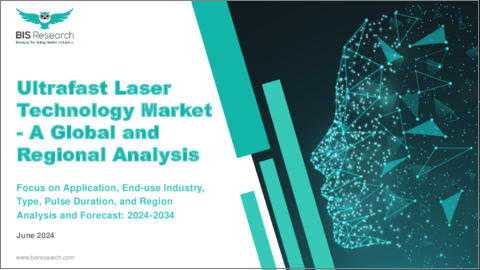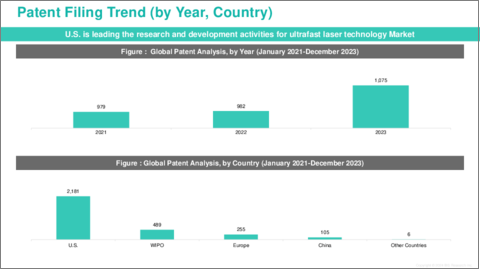|
|
市場調査レポート
商品コード
1492697
超高速レーザー技術市場- 世界および地域別分析:用途別、製品別、地域別 - 分析と予測(2024年~2034年)Ultrafast Laser Technology Market - A Global and Regional Analysis: Focus on Application, End-use Industry, Type, Pulse Duration, and Region - Analysis and Forecast, 2024-2034 |
||||||
カスタマイズ可能
|
|||||||
| 超高速レーザー技術市場- 世界および地域別分析:用途別、製品別、地域別 - 分析と予測(2024年~2034年) |
|
出版日: 2024年06月12日
発行: BIS Research
ページ情報: 英文 100 Pages
納期: 1~5営業日
|
全表示
- 概要
- 目次
超高速レーザー技術の市場規模は、高精度製造技術への要求の高まり、バイオメディカル用途での利用の増加、高速データ伝送と光通信への需要の高まりに後押しされて、大きく拡大しています。
楽観的シナリオを考慮すると、2024年の市場規模は26億8,000万米ドルで、今後は11.73%のCAGRで拡大し、2034年には81億1,000万米ドルに達すると予測されています。
| 主要市場統計 | |
|---|---|
| 予測期間 | 2024年~2034年 |
| 2024年評価 | 26億8,000万米ドル |
| 2034年予測 | 81億1,000万米ドル |
| CAGR | 11.73% |
こうしたプラス要因にもかかわらず、市場は、主に医療や防衛用途において、安全性や規制遵守とともに、非常に複雑で高価なシステムなどのハードルに直面しています。しかし、量子技術を含む新市場での用途の拡大は、超高速レーザー技術の需要拡大のための有利な機会を提示し、特定の材料の加工や高スループットの達成における限界への課題を克服しながら、この市場の活気ある将来を示唆しています。
北米は、超高速レーザー技術開発の最前線にある多くの大手企業や研究機関の本拠地です。レーザ光源、パルス整形技術、用途の絶え間ない進歩が、この地域の超高速レーザの能力と市場の可能性を拡大しています。北米は、製造、航空宇宙、防衛、ヘルスケア、研究など、超高速レーザー技術の恩恵を受ける主要産業で強い存在感を示しています。これらの産業における超高速レーザの需要は、精密な微細加工、材料加工、バイオメディカルイメージング、科学研究を可能にする能力によって牽引されています。医療・バイオメディカル分野では、超高速レーザはレーザ眼科手術(LASIK)、皮膚科治療、眼科、バイオメディカルイメージングなどの分野に使用されています。米国の医療機器企業や研究機関がこの分野の技術革新を推進し、臨床現場での超高速レーザー技術の採用につながっています。
当レポートでは、世界の超高速レーザー技術市場について調査し、市場の概要とともに、用途別、製品別、地域別の動向、および市場に参入する企業のプロファイルなどを提供しています。
目次
エグゼクティブサマリー
第1章 市場:業界の見通し
- 動向:現在および将来の影響評価
- サプライチェーンの概要
- R&Dレビュー
- 規制状況
- ステークホルダー分析
- 主要な世界的イベントの影響分析
- 市場力学の概要
第2章 超高速レーザー技術市場(用途別)
- 用途のセグメンテーション
- 用途の概要
- 超高速レーザー技術市場(用途別)
- 超高速レーザー技術市場(最終用途産業別)
第3章 超高速レーザー技術市場(製品別)
- 製品セグメンテーション
- 製品概要
- 超高速レーザー技術市場(タイプ別)
- 超高速レーザー技術市場(パルス持続時間別)
第4章 超高速レーザー技術市場(地域別)
- 超高速レーザー技術市場(地域別)
- 北米
- 欧州
- アジア太平洋
- その他の地域
第5章 企業プロファイル
- 今後の見通し
- 地理的評価
- TRUMPF
- Coherent Corp.
- IPG Photonics Corporation
- Novanta
- Fluence
- NKT Photonics A/S
- Wuhan Huaray Precision Laser Co., Ltd.
- DPSS Lasers Inc.
- Lumentum Operations LLC
- Amplitude Laser
- Hamamatsu Photonics K.K.
- Jenoptik
- Newport Corporation
- Fastlite
- MKS Instruments
- その他
第6章 調査手法
Introduction to Ultrafast Laser Technology Market
Ultrafast laser technology market is experiencing significant growth, propelled by growing requirement for high-precision manufacturing techniques, increasingly used in biomedical applications and growing demand for high-speed data transmission and optical communications. Considering the optimistic scenario the market is valued at $2.68 billion in 2024 and is expected to grow at a CAGR of 11.73% to reach $8.11 billion by 2034.
| KEY MARKET STATISTICS | |
|---|---|
| Forecast Period | 2024 - 2034 |
| 2024 Evaluation | $2.68 Billion |
| 2034 Forecast | $8.11 Billion |
| CAGR | 11.73% |
Despite these positive drivers, the market faces hurdles such as highly complex and expensive systems along with safety and compliance with regulations, mainly in medical and defense applications. However, increasing applications in new markets including quantum technologies, present lucrative opportunities for the expansion of ultrafast laser technology demand, suggesting a vibrant future for this market as it navigates through challenges towards limitations in processing certain materials or achieving high throughput.
North America is home to many leading companies and research institutions at the forefront of ultrafast laser technology development. Continuous advancements in laser sources, pulse shaping techniques, and applications have expanded the capabilities and market potential of ultrafast lasers in the region. North America has a strong presence in key industries that benefit from ultrafast laser technology, including manufacturing, aerospace, defense, healthcare, and research. The demand for ultrafast lasers in these industries is driven by their ability to enable precise micromachining, materials processing, biomedical imaging, and scientific research applications. In the medical and biomedical fields, ultrafast lasers are used for applications such as laser eye surgery (LASIK), dermatology treatments, ophthalmology, and biomedical imaging. U.S. medical device companies and research institutions have been driving innovation in this area, leading to the adoption of ultrafast laser technology in clinical settings.
The increasing research and development (R&D) efforts in the ultrafast laser market are driven by the need to address a wider range of materials and applications. Companies, universities and research institutes are putting efforts on developing ultrafast laser systems capable of processing a broader range of materials, including metals, semiconductors, ceramics, polymers, composites, and biomaterials. This involves optimizing laser parameters such as pulse duration, repetition rate, wavelength, and energy to achieve efficient and precise material processing. For instance, in In November 2023, the University of Nebraska launched a novel laser technology aimed at advancing the manufacturing methods of the future. The University of Nebraska-Lincoln's Center for Electro-Optics and Functionalized Surfaces introduced the first-of-its-kind laser in the United States, specifically designed for a specialized surface modification technique. This innovative approach utilizes femtosecond laser surface processing, which involves directing an ultrafast laser onto metal materials to alter their micro- and nanoscale features as well as their chemical composition. Researchers are exploring new applications and industries where ultrafast lasers can deliver value, such as consumer electronics, renewable energy, quantum technologies, advanced materials, and cultural heritage preservation. This involves adapting laser systems and processing techniques to meet the specific requirements of each application, whether it's cutting, drilling, welding, marking, surface structuring, or micro/nano fabrication.
Market Segmentation:
Segmentation 1: by Application
- Micromachining
- Bio-Imagin
- Scientific Research
- Medical Device Fabrication
- Cardiovascular Stent Manufacturing
- Others
Segmentation 2: by End-use Industry
- Medical
- Consumer Electronics
- Automotive
- Aerospace & Defense
- Industrial
- Others
Segmentation 3: by Type
- Mode-Locked Lasers
- Titanium-Sapphire Lasers
- Fiber Lasers
- Diode-Pumped Bulk Lasers
- Dye Lasers
- Diode Lasers
- Others
Segmentation 4: by Pulse Duration
- Picosecond
- Femtosecond
Segmentation 5: by Region
- North America
- Europe
- Asia-Pacific
- Rest-of-the-World
How can this report add value to an organization?
Product/Innovation Strategy: The global ultrafast laser technology market has been extensively segmented based on various categories, such as application, end-use industry, type, and pulse duration. This can help readers get a clear overview of which segments account for the largest share and which ones are well-positioned to grow in the coming years.
Competitive Strategy: A detailed competitive benchmarking of the players operating in the global ultrafast laser technology market has been done to help the reader understand how players stack against each other, presenting a clear market landscape. Additionally, comprehensive competitive strategies such as partnerships, agreements, and collaborations will aid the reader in understanding the untapped revenue pockets in the market.
Key Market Players and Competition Synopsis
The companies that are profiled have been selected based on thorough secondary research, which includes analyzing company coverage, product portfolio, market penetration, and insights gathered from primary experts.
Some of the prominent companies in this market are:
- Amplitude Laser
- Coherent Corp.
- NKT Photonics A/S
- Hamamatsu Photonics K.K.
- MKS Instruments
- Fluence
Key Questions Answered in this Report:
- What are the main factors driving the demand for ultrafast laser technology market?
- What are the major patents filed by the companies active in the ultrafast laser technology market?
- Who are the key players in the ultrafast laser technology market, and what are their respective market shares?
- What partnerships or collaborations are prominent among stakeholders in the ultrafast laser technology market?
- What are the strategies adopted by the key companies to gain a competitive edge in ultrafast laser technology market?
- What is the futuristic outlook for the ultrafast laser technology market in terms of growth potential?
- What is the current estimation of the ultrafast laser technology market, and what growth trajectory is projected from 2024 to 2034?
- Which application, and product segment is expected to lead the market over the forecast period (2024-2034)?
- Which regions demonstrate the highest adoption rates for ultrafast laser technology market, and what factors contribute to their leadership?
Table of Contents
Executive Summary
Scope and Definition
Market/Product Definition
Key Questions Answered
Analysis and Forecast Note
1. Markets: Industry Outlook
- 1.1 Trends: Current and Future Impact Assessment
- 1.2 Supply Chain Overview
- 1.2.1 Value Chain Analysis
- 1.2.2 Pricing Forecast
- 1.3 R&D Review
- 1.3.1 Patent Filing Trend by Country, by Company
- 1.4 Regulatory Landscape
- 1.5 Stakeholder Analysis
- 1.5.1 Use Case
- 1.5.2 End User and Buying Criteria
- 1.6 Impact Analysis for Key Global Events
- 1.7 Market Dynamics Overview
- 1.7.1 Market Drivers
- 1.7.2 Market Restraints
- 1.7.3 Market Opportunities
2. Ultrafast Laser Technology Market (by Application)
- 2.1 Application Segmentation
- 2.2 Application Summary
- 2.3 Ultrafast Laser Technology Market (by Application)
- 2.3.1 Micromachining
- 2.3.2 Bio-Imagin
- 2.3.3 Scientific Research
- 2.3.4 Medical Device Fabrication
- 2.3.5 Cardiovascular Stent Manufacturing
- 2.3.6 Others
- 2.4 Ultrafast Laser Technology Market (by End-use Industry)
- 2.4.1 Medical
- 2.4.2 Consumer Electronics
- 2.4.3 Automotive
- 2.4.4 Aerospace & Defense
- 2.4.5 Industrial
- 2.4.6 Others
3. Ultrafast Laser Technology Market (by Product)
- 3.1 Product Segmentation
- 3.2 Product Summary
- 3.3 Ultrafast Laser Technology Market (by Type)
- 3.3.1 Mode-Locked Lasers
- 3.3.2 Titanium-Sapphire Lasers
- 3.3.3 Fiber Lasers
- 3.3.4 Diode-Pumped Bulk Lasers
- 3.3.5 Dye Lasers
- 3.3.6 Diode Lasers
- 3.3.7 Others
- 3.4 Ultrafast Laser Technology Market (by Pulse Duration)
- 3.4.1 Picosecond
- 3.4.2 Femtosecond
4. Ultrafast Laser Technology Market (by Region)
- 4.1 Ultrafast Laser Technology Market (by Region)
- 4.2 North America
- 4.2.1 Regional Overview
- 4.2.2 Driving Factors for Market Growth
- 4.2.3 Factors Challenging the Market
- 4.2.4 Application
- 4.2.5 Product
- 4.2.6 U.S.
- 4.2.6.1 Market by Application
- 4.2.6.2 Market by Product
- 4.2.7 Canada
- 4.2.7.1 Market by Application
- 4.2.7.2 Market by Product
- 4.2.8 Mexico
- 4.2.8.1 Market by Application
- 4.2.8.2 Market by Product
- 4.3 Europe
- 4.3.1 Regional Overview
- 4.3.2 Driving Factors for Market Growth
- 4.3.3 Factors Challenging the Market
- 4.3.4 Application
- 4.3.5 Product
- 4.3.6 Germany
- 4.3.6.1 Market by Application
- 4.3.6.2 Market by Product
- 4.3.7 France
- 4.3.7.1 Market by Application
- 4.3.7.2 Market by Product
- 4.3.8 U.K.
- 4.3.8.1 Market by Application
- 4.3.8.2 Market by Product
- 4.3.9 Italy
- 4.3.9.1 Market by Application
- 4.3.9.2 Market by Product
- 4.3.10 Rest-of-Europe
- 4.3.10.1 Market by Application
- 4.3.10.2 Market by Product
- 4.4 Asia-Pacific
- 4.4.1 Regional Overview
- 4.4.2 Driving Factors for Market Growth
- 4.4.3 Factors Challenging the Market
- 4.4.4 Application
- 4.4.5 Product
- 4.4.6 China
- 4.4.6.1 Market by Application
- 4.4.6.2 Market by Product
- 4.4.7 Japan
- 4.4.7.1 Market by Application
- 4.4.7.2 Market by Product
- 4.4.8 India
- 4.4.8.1 Market by Application
- 4.4.8.2 Market by Product
- 4.4.9 South Korea
- 4.4.9.1 Market by Application
- 4.4.9.2 Market by Product
- 4.4.10 Rest-of-Asia-Pacific
- 4.4.10.1 Market by Application
- 4.4.10.2 Market by Product
- 4.5 Rest-of-the-World
- 4.5.1 Regional Overview
- 4.5.2 Driving Factors for Market Growth
- 4.5.3 Factors Challenging the Market
- 4.5.4 Application
- 4.5.5 Product
- 4.5.6 South America
- 4.5.6.1 Market by Application
- 4.5.6.2 Market by Product
- 4.5.7 Middle East and Africa
- 4.5.7.1 Market by Application
- 4.5.7.2 Market by Product
5. Companies Profiled
- 5.1 Next Frontiers
- 5.2 Geographic Assessment
- 5.2.1 TRUMPF
- 5.2.1.1 Overview
- 5.2.1.2 Top Products/Product Portfolio
- 5.2.1.3 Top Competitors
- 5.2.1.4 Target Customers
- 5.2.1.5 Key Personnel
- 5.2.1.6 Analyst View
- 5.2.1.7 Market Share
- 5.2.2 Coherent Corp.
- 5.2.2.1 Overview
- 5.2.2.2 Top Products/Product Portfolio
- 5.2.2.3 Top Competitors
- 5.2.2.4 Target Customers
- 5.2.2.5 Key Personnel
- 5.2.2.6 Analyst View
- 5.2.2.7 Market Share
- 5.2.3 IPG Photonics Corporation
- 5.2.3.1 Overview
- 5.2.3.2 Top Products/Product Portfolio
- 5.2.3.3 Top Competitors
- 5.2.3.4 Target Customers
- 5.2.3.5 Key Personnel
- 5.2.3.6 Analyst View
- 5.2.3.7 Market Share
- 5.2.4 Novanta
- 5.2.4.1 Overview
- 5.2.4.2 Top Products/Product Portfolio
- 5.2.4.3 Top Competitors
- 5.2.4.4 Target Customers
- 5.2.4.5 Key Personnel
- 5.2.4.6 Analyst View
- 5.2.4.7 Market Share
- 5.2.5 Fluence
- 5.2.5.1 Overview
- 5.2.5.2 Top Products/Product Portfolio
- 5.2.5.3 Top Competitors
- 5.2.5.4 Target Customers
- 5.2.5.5 Key Personnel
- 5.2.5.6 Analyst View
- 5.2.5.7 Market Share
- 5.2.6 NKT Photonics A/S
- 5.2.6.1 Overview
- 5.2.6.2 Top Products/Product Portfolio
- 5.2.6.3 Top Competitors
- 5.2.6.4 Target Customers
- 5.2.6.5 Key Personnel
- 5.2.6.6 Analyst View
- 5.2.6.7 Market Share
- 5.2.7 Wuhan Huaray Precision Laser Co., Ltd.
- 5.2.7.1 Overview
- 5.2.7.2 Top Products/Product Portfolio
- 5.2.7.3 Top Competitors
- 5.2.7.4 Target Customers
- 5.2.7.5 Key Personnel
- 5.2.7.6 Analyst View
- 5.2.7.7 Market Share
- 5.2.8 DPSS Lasers Inc.
- 5.2.8.1 Overview
- 5.2.8.2 Top Products/Product Portfolio
- 5.2.8.3 Top Competitors
- 5.2.8.4 Target Customers
- 5.2.8.5 Key Personnel
- 5.2.8.6 Analyst View
- 5.2.8.7 Market Share
- 5.2.9 Lumentum Operations LLC
- 5.2.9.1 Overview
- 5.2.9.2 Top Products/Product Portfolio
- 5.2.9.3 Top Competitors
- 5.2.9.4 Target Customers
- 5.2.9.5 Key Personnel
- 5.2.9.6 Analyst View
- 5.2.9.7 Market Share
- 5.2.10 Amplitude Laser
- 5.2.10.1 Overview
- 5.2.10.2 Top Products/Product Portfolio
- 5.2.10.3 Top Competitors
- 5.2.10.4 Target Customers
- 5.2.10.5 Key Personnel
- 5.2.10.6 Analyst View
- 5.2.10.7 Market Share
- 5.2.11 Hamamatsu Photonics K.K.
- 5.2.11.1 Overview
- 5.2.11.2 Top Products/Product Portfolio
- 5.2.11.3 Top Competitors
- 5.2.11.4 Target Customers
- 5.2.11.5 Key Personnel
- 5.2.11.6 Analyst View
- 5.2.11.7 Market Share
- 5.2.12 Jenoptik
- 5.2.12.1 Overview
- 5.2.12.2 Top Products/Product Portfolio
- 5.2.12.3 Top Competitors
- 5.2.12.4 Target Customers
- 5.2.12.5 Key Personnel
- 5.2.12.6 Analyst View
- 5.2.12.7 Market Share
- 5.2.13 Newport Corporation
- 5.2.13.1 Overview
- 5.2.13.2 Top Products/Product Portfolio
- 5.2.13.3 Top Competitors
- 5.2.13.4 Target Customers
- 5.2.13.5 Key Personnel
- 5.2.13.6 Analyst View
- 5.2.13.7 Market Share
- 5.2.14 Fastlite
- 5.2.14.1 Overview
- 5.2.14.2 Top Products/Product Portfolio
- 5.2.14.3 Top Competitors
- 5.2.14.4 Target Customers
- 5.2.14.5 Key Personnel
- 5.2.14.6 Analyst View
- 5.2.14.7 Market Share
- 5.2.15 MKS Instruments
- 5.2.15.1 Overview
- 5.2.15.2 Top Products/Product Portfolio
- 5.2.15.3 Top Competitors
- 5.2.15.4 Target Customers
- 5.2.15.5 Key Personnel
- 5.2.15.6 Analyst View
- 5.2.15.7 Market Share
- 5.2.16 Others
- 5.2.1 TRUMPF





